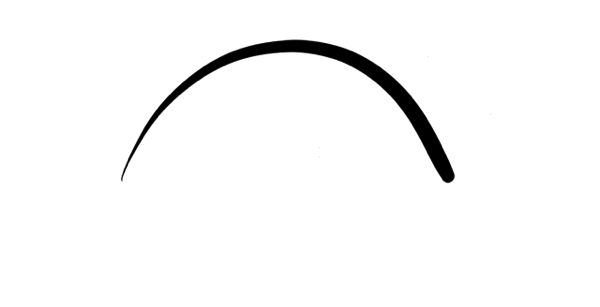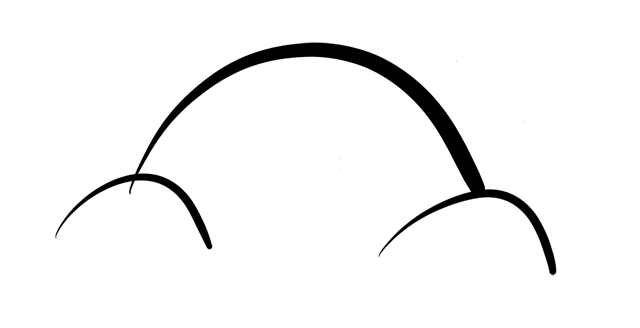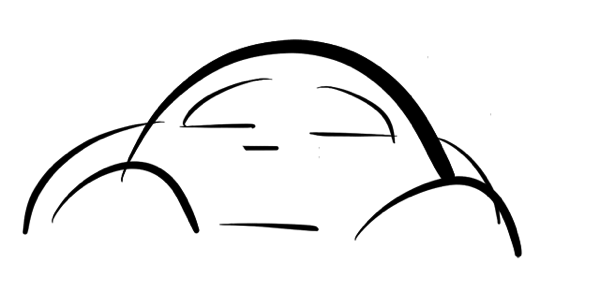Drinking a beer having finished playing records at the last Wild Rumpus, I got talking to Cara. She asked me a difficult question. Later, she would write this up in her embedded look at the London indie scene, and make me sound more profound than I think I did. It’s a very good article; you should go and read it.
Still, with the advantage of time, I wanted to write down the two things I said to her for posterity, because they’re worth bearing in mind, and I want to remember them for myself.
Disclaimer: like so many of the so-called “smart things” I’ve ever said, this is basically a Matt Jones paraphrase.
Jones once explained, talking in the studio one day, a theory that had come from car design: First Read / Second Read.
What I remember him saying:
to design a really memorable car, you need a strong first read. A really strong first read. That’s the single shape, barely a single line that you remember at a glance. Like this:

You know what car I’m showing you already.
But: it’s not enough to have a strong first read. Then, when you’re closer, or double-taking, you need a strong second-read: that detail echoed, firming up the original shape, but making the coherence clear:

And then, on the third read, once you’ve encompassed the detail therein, you still need something to satisfy the eye: details to take in, subtleties and shapes.

The Beetle is an obvious way of showing this, but it really works: it’s not just that strong first read that makes the Beetle so beautiful; it’s the strong first, second, and third reads all co-existing at once that make it work quite so well. Detail that you never get sucked into won’t work; a striking first impression that goes nowhere won’t work.
And Jones, astute as ever, would point out this applied to many forms of design: often, getting the strong first read would be hard, sucking someone into the detail we’d made – but sometimes, you’d also have to focus on backing up that first read with detail.
(Fashion does this well, for instance – the emphasis on understanding form often coming from a silhouette, and then the eye taking in more than just the outline.)
I think the best games do this. Cara mentioned the FPS example, but to be frank, it applies to anything: card games; beat-em-ups; sports; real-time-strategy. The first read has to be clear, broad: grokkable, and also aesthetically enticing. Once enticed, you need that detail to repeat, to be fractal, to be backed up by substance. And then, as you delve deeper, into expertise and experience, there’s still depth to reward you, but it never clashes against that first read you had, the thing that sucked you in.
As I write that, I realise: it’s not so far from MDA. But I’m aware I can get a bit hardline about MDA, and actually, first/second/third read speaks to everything: that moment you discover depth in the aesthetics of a game that echoes the surface; or similarly, a first read of why a mechanic is fun (‘we’re all sharing the same resources, but have our own goals!‘).
I suppose the real point is: designing for depth is not about neglecting the surface. It’s about leading the player on that journey to expertise, satisfying them at all turns of the path. It’s no surprise my favourite beat-em-ups are both simple on the surface and the most beautiful. It’s no surprise my favourite card games have the simplest surface rules, but a deep path to expertise, usually based on inter-personal interactions – fakeouts, Yomi.
I used to say that I really liked the idea of being able to recognise a game at 20ft – you see someone with a phone on the Tube and you just know that they’re playing something different that far away. Is it through the aesthetic? Is it through how they interact? I don’t know – it doesn’t matter. What matters is that you can read it that far away. And then, you get closer, and you want to read more detail: not just clearer graphics, but also clearer interactions, clearer mechanics. We start to suck players in when they see a screen in a friend’s house and say “What’s that?” And that’s the real challenge, I reckon: designing that path in.
There’s another side to this question though.
The original question Cara asked me, standing in BL-NK, was “As a games designer, what do you want players to do?”
I thought for a bit, and said: well, follow the rules, of course. Play the game as intended, and enjoy it. Then, I realised that was the wrong answer. So I correct course.
Because what I’ve learned about some of the best games I’ve worked on, designed, or played, was that they design well for failure states. I’ve designed games that were fun if you played them right, but terrible if you didn’t get the rules.
They were not good games.
By contrast, games that are great if you play as the designer intended – but also great if you play them your way, if you get lost in the components and the systems and recompose them in some other form that still excites and entertains you: well, that’s good too.
Good games are resilient. This is why people sometimes have house rules for Mario Kart, for Catan. This is why people play in large sandbox games without completing missions. This is why RPG GMs will throw the rulebook out to tell a better story.
So I said that, first of all – that I’d like to design for resilience.
And then I added an addendum: whilst it’d be good if games were resilient to misinterpretation, to being played with, the best games afford that but you rarely go down that path, because they lead you on this great journey, from surface read to deep expertise (and frequently back out again, as you show a new friend the surface of a favourite game).
And I told a story about the Volkswagen Beetle.